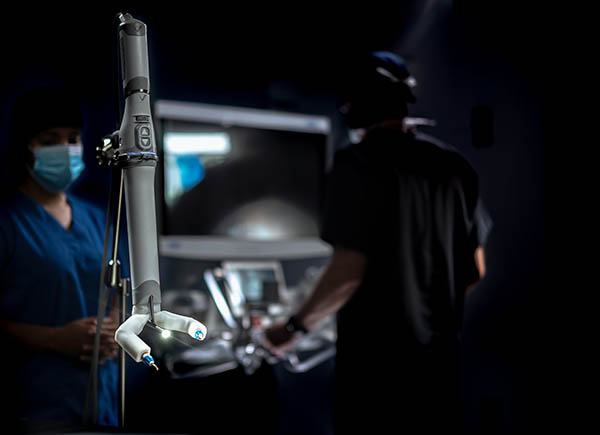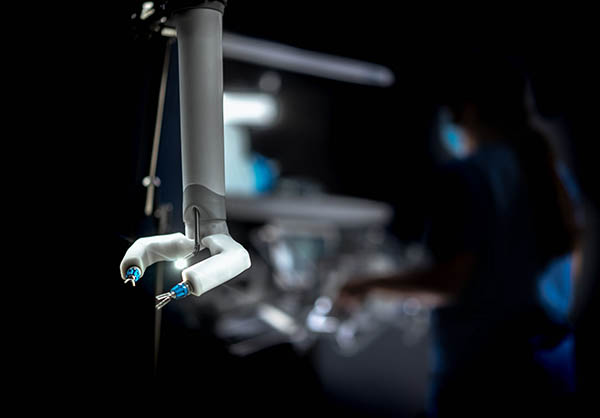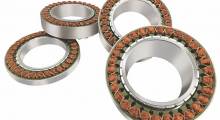In space, robots could someday make housecalls for doctors far from astronauts. Virtual Incision Corp. last week announced that it will test its MIRA surgical robot's skills in a 2024 technology demonstration mission aboard the International Space Station, or ISS.
“The Virtual Incision MIRA platform was designed to deliver the power of a mainframe robotic-assisted surgery [RAS] device in a miniaturized size, with the goal of making RAS accessible in any operating room on the planet,” stated John Murphy, CEO of Virtual Incision. “Working with NASA aboard the space station will test how MIRA can make surgery accessible in even the most faraway places.”
Virtual Incision said it holds more than 200 patents and patent applications. It raised $43 million in Series C funding in November 2021. The Lincoln, Neb.-based company claimed that MIRA is the first RAS platform of its kind.
Virtual Incision designs for portability, fast setup
MIRA's small design could offer the benefits of RAS during abdominal procedures without the logistical inefficiencies of traditional mainframe systems, said Virtual Incision. The device weighs about 2 lb. and avoids the need for a dedicated mainframe room, the company added.
With its drape- and dock-free design and portability, MIRA is quick to set up, clean, and move in between cases, according to Virtual Incision. The company said the system could allow healthcare providers to increase their robotic-assisted surgery caseload.
MIRA is currently in U.S. Food and Drug Administration (FDA) clinical trials under an investigational device exemption (IDE) and is not yet available for sale. MIRA is currently in the final stages of its U.S. clinical trial.
“I’ve been excited about the ongoing trial thus far because we have confirmed many of the design attributes of MIRA,” said Shane Farritor, co-founder and chief technology officer at Virtual Incision. “For example, the device really can be set up in many different operating rooms.”
“Also, the device can be easily and quickly moved to various quadrants inside the abdominal cavity. Many of these attributes have been highlighted in our trial,” he told Robotics 24/7. “Our hope is to submit to the FDA [for final approval] around the end of 2022.”
NASA to conduct surgical trials in space
The National Aeronautics and Space Administration (NASA) recently awarded the grant to the University of Nebraska-Lincoln through the Established Program to Stimulate Competitive Research (EPSCoR) at the University of Nebraska Omaha.
Virtual Incision said MIRA's small size makes it appealing to surgeons and hospital staffers. The design is also suitable for use within the tight space and mass requirements of a long-duration space mission, said the company.
To prepare MIRA for use in space, the robot will need to be secured for launch, include self-contained sessions, and get approval from various stakeholders, acknowledged Farritor.
“MIRA is being well-tested for use in terrestrial applications,” he told Robotics 24/7. “A lot of effort has gone into building a reliable and robust device.”
“However, there will be a lot of new challenges for using MIRA in zero gravity,” Farritor said. “Nothing about space flight is easy, and I’d hate to pick a 'biggest.'”

MIRA to simulate surgical tasks on ISS
Once aboard the ISS, MIRA will operate inside a microwave-oven-sized experiment locker and perform activities that simulate those used in surgery, such as cutting simulated tissue and manipulating small objects. The robot will act with a minimum of input from the crew, noted Farritor.
“This will simply be a technology demonstration,” he said. “The astronaut will flip a switch, and MIRA will then operate simulated surgical tasks on its own. This is different from how MIRA works on earth, where a surgeon is the one facilitating the movement.”
“NASA has ambitious plans for long-duration space travel, and it’s important to test the capabilities of technology that may be beneficial during missions measured in months and years,” said Farritor. “MIRA continues to push the boundaries of what’s possible in RAS, and we are pleased with its performance so far during clinical trials.”
“We’re excited to take it a step further and help identify what could be possible in the future as space travel is becoming more of a reality for mankind,” he said. The ISS has hosted a variety of robots, including robotic arms, floating assistive systems, and humanoid models.
Robots could enable surgery near and far
In addition, MIRA has potential for field use here on Earth, said Farritor. “We believe the small size of MIRA simplifies its use on Earth because it is portable and easy to set up,” he noted. “Use on the ISS will dramatically demonstrate MIRA’s portability and that it really can be used anywhere, any time.”
“Our research inside the University of Nebraska has had long-standing sponsorship from both the [U.S.] Army and NASA because both want to do surgery in forward and far-off environments,” Farritor said. “In the long-term, we think telemedicine is a real possibility for this technology.”
“MIRA’s portability and small size means it can easily be transported,” he said. “[This] is a key differentiator of MIRA, as other RAS platforms require a dedicated OR with scheduling limitations.
Farritor serves as professor of engineering at the University of Nebraska-Lincoln, where he has led research on the potential use of surgical robots in space. Prior to Virtual Incision, Farritor studied at the Kennedy Space Center, Goddard Space Flight Center, and the Jet Propulsion Laboratory.
He co-founded Virtual Incision with Dmitry Oleynikov, MD. They have combined their experience in engineering and minimally invasive surgery to help create MIRA.
About the Author
Follow Robotics 24/7 on Linkedin
Article topics
Email Sign Up















